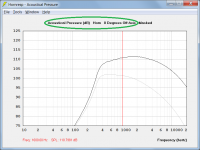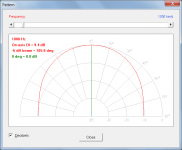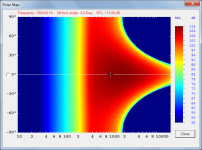"It's not just about me and my dream of doing nothing. It's about all of us."
So I'm stuck at home with a cold and I've been wasting way too much time modeling speakers in HornResp today.
Here's some sims I did of the wavefronts of horns in HornResp.

First up is a plain ol' conical horn. Here are the specs:
1) The throat is 2" in diameter (6,750Hz)
2) The mouth is 15" in diameter (900Hz)
3) The coverage angle is 60 degrees
So I'm stuck at home with a cold and I've been wasting way too much time modeling speakers in HornResp today.
Here's some sims I did of the wavefronts of horns in HornResp.

First up is a plain ol' conical horn. Here are the specs:
1) The throat is 2" in diameter (6,750Hz)
2) The mouth is 15" in diameter (900Hz)
3) The coverage angle is 60 degrees

Second up is a conical horn, but with a flare at the mouth. This innovation was documented by Keele, and used by Danley in his Synergy Horns. Here are the specs:
1) The throat is 2" in diameter (6,750Hz)
2) The mouth is 15" in diameter (900Hz)
3) The coverage angle is 60 degrees (Note that the coverage angle will expand a bit due to the expansion at the throat.)
In the sims, note that the polars are cleaner due to the gradual expansion at the throat. But also notice that the depth is quite a bit shallower also.

Subtle smoothing at the mouth of the horn from post #2 improves the polars, as illustrated above. Width of the horn is identical.
Subtle smoothing at the mouth of the horn from post #2 improves the polars, as illustrated above. Width of the horn is identical.
The interesting horns, like the Klipsch K-402, are Frankenstein Horns with a few different profiles blended together in ABS plastic:
OS profile - throat
modified tractrix - body
Radius - mouth exit
As your example shows, tough to model accurately.
Interesting work, Patrick!
Isn't the k402 straightsided with a tractrix ending/mouth?
http://www.usaudiomart.com/details/649168800-klipsch-k402-horn/images/880140/
Isn't the k402 straightsided with a tractrix ending/mouth?
http://www.usaudiomart.com/details/649168800-klipsch-k402-horn/images/880140/
Last edited:
Hi Patrick,
Again interesting work done by you - thanks a lot.
I did something similar in a thread in a German DIY Hifi Forum, i.e. working on 'Waveguides and constant directivity' just using AxiDriver instead of Hornresponse.
Can be found here if interested. Watch out, it's German and needs some on-line translation probably.
Get well soon!
Christoph
Again interesting work done by you - thanks a lot.
I did something similar in a thread in a German DIY Hifi Forum, i.e. working on 'Waveguides and constant directivity' just using AxiDriver instead of Hornresponse.
Can be found here if interested. Watch out, it's German and needs some on-line translation probably.
Get well soon!
Christoph
Patrick,
I can't really see where the subtle smoothing at the mouth is improving the polars (in that simulation, that is). The "lumps" within the horn are at slightly different places, but further out it appears they are visually equally smooth in coverage but the smoothed mouth loses directivity (starts to follow the angle of the widened mouth instead of the general walls) at the lowest modeled frequency, compared to the keele-type mouth. Via non-calibrated eyeball, anyway.
I can't really see where the subtle smoothing at the mouth is improving the polars (in that simulation, that is). The "lumps" within the horn are at slightly different places, but further out it appears they are visually equally smooth in coverage but the smoothed mouth loses directivity (starts to follow the angle of the widened mouth instead of the general walls) at the lowest modeled frequency, compared to the keele-type mouth. Via non-calibrated eyeball, anyway.
The interesting horns, like the Klipsch K-402, are Frankenstein Horns with a few different profiles blended together in ABS plastic:
OS profile - throat
modified tractrix - body
Radius - mouth exit
As your example shows, tough to model accurately.
The throat of the K-402 is not oblate spheroid (OS). The horn mouth is tractrix in both directions, thus making the area expansion a tractrix curve. The rest of the horn is not a conical expansion: refer to Beranek's text and also Olson's text for the formula for conical expansion.
Most people have not laid out a tractrix curve before. To make a tractrix curve, start with a weight tied to a string that is approximately the radius of the horn's mouth. Pull the string tight, then start pulling that string at 90 degrees to the direction of the weight. The path taken by that weight is a tractrix curve. The K-402 is a much shorter horn than a full tractrix expansion. The reason why I used it as the basis of a full-range multiple-entry horn (MEH) is due in part to that property.
Notice that the horn's profile always starts at the mouth, not the throat. To design a modified tractrix horn, you modify the curve after the mouth is drawn, not the throat end. When you look at the K-402, pay close attention to that.
Roy Delgado (its designer, protege of Paul Klipsch, and the current chief engineer of Klipsch's Professional products) designed and tested about 40 modified tractrix profiles before reaching the present horn profiles of the K-510, and later the K-402.
It does make a difference how the exact horn's mouth, throat, and body is shaped. The rough approximation by Keele was one of the starting points of an extensive design process.
Chris
Patrick,
I can't really see where the subtle smoothing at the mouth is improving the polars (in that simulation, that is). The "lumps" within the horn are at slightly different places, but further out it appears they are visually equally smooth in coverage but the smoothed mouth loses directivity (starts to follow the angle of the widened mouth instead of the general walls) at the lowest modeled frequency, compared to the keele-type mouth. Via non-calibrated eyeball, anyway.
Nice catch Bill. That's what I get for playing with HornResp for seventeen hours straight lol.
Here's what happened:
In the last set of sims that I posted, there is a VERY subtle smoothing to the horn. If you compare the last, and the second to last, I smoothed out the spline a teensy bit.
The idea is to mimim what 18Sound and JBL do these days, where their waveguides have a VERY subtle curvature. They're largely conical, but the devil is in the details - smoothing out the transition from the throat to the body of the horn, and from the mouth to the body of the horn makes a measurable difference.
But here's the problem:
In my last post, at 2:30am, only HALF of the pics have that subtle adjustment. The sims at 1000Hz and 2000Hz have that subtle adjustment.
You can see the difference if you compare the 2000Hz simulation from Post #2 to the 2000Hz simulation from post #3. The difference is that the wavefronts in the latter are smoother. They also to be "brighter" which would indicate the waveguide will be louder.
In the real world, what I've noticed with waveguides that follow this criteria, as detailed in the "great waveguide" thread, is that those waveguides are measurably smoother. The QSC 60x90 waveguide in particular:
Having said all that, note that the biggest 'bang for the buck' appears to be simply increasing the expansion rate for the last third, like Keele recommends and Danley does. But if you want to get that last 5% out of the horn, it's worthwhile to get a big file out, and grind down the transition from the two angles, so it's perfectly smooth, particularly at the throat and the mouth.
Another interesting thing you'll notice from the Hornresp sims is that the wavefronts will 'detach' from the walls in a conical horn once the angle gets wide enough.
Last year I ran some sims using the 3D software from the Akabak folks, and that seemed to confirm that. (Not recommended! Took me all day to get one sim to work.)
Last edited:
Can I read a description somewhere of the modified tractrix so that I can see what it does?Notice that the horn's profile always starts at the mouth, not the throat. To design a modified tractrix horn, you modify the curve after the mouth is drawn, not the throat end. When you look at the K-402, pay close attention to that.
That hasn't been disclosed in a white paper unfortunately (modified tractrix, that is). I believe that to some degree it's considered company private information. But nothing is patented, and even if it were, the patents would have run their course--20 years from patent application date in the US.
But the geometries are clearly apparent from measuring the horns themselves. All you need do is buy a horn and measure it carefully.
I think a lot of the time, DIYers are actually searching for "constant coverage" (i.e., very wide-band constant directivity in each horn's axis), but Hornresp itself really only provides power response...a lumped parameter for all its output, and its polars are really just barely modellable using its add-on visual simulator, as is shown in this thread (...not to hijack this thread, PB--I'm merely answering the question posed).
While this is useful, in my estimation it's far from sufficient. What's really needed is some form of industrial grade polar prediction tool...perhaps ABEC3 (apparently, since I currently do not use this tool--which costs real money). But it seems as if most DIYers aren't interested in the time and effort required to build up 3D models in a boundary element+lumped element simulator. It's a significant undertaking to be sure, but one worthy of the effort if improved horn profiles is the goal. I believe that at least one person has tried to tackle ABEC3 here on this forum.
That's where something like the K-402 and K-510 profiles come into play. These are real horns that actually work the way that most DIYers want them to work. It helps to study these solutions that work first then try your own hand at unexplored designs.
Chris
But the geometries are clearly apparent from measuring the horns themselves. All you need do is buy a horn and measure it carefully.
I think a lot of the time, DIYers are actually searching for "constant coverage" (i.e., very wide-band constant directivity in each horn's axis), but Hornresp itself really only provides power response...a lumped parameter for all its output, and its polars are really just barely modellable using its add-on visual simulator, as is shown in this thread (...not to hijack this thread, PB--I'm merely answering the question posed).
While this is useful, in my estimation it's far from sufficient. What's really needed is some form of industrial grade polar prediction tool...perhaps ABEC3 (apparently, since I currently do not use this tool--which costs real money). But it seems as if most DIYers aren't interested in the time and effort required to build up 3D models in a boundary element+lumped element simulator. It's a significant undertaking to be sure, but one worthy of the effort if improved horn profiles is the goal. I believe that at least one person has tried to tackle ABEC3 here on this forum.
That's where something like the K-402 and K-510 profiles come into play. These are real horns that actually work the way that most DIYers want them to work. It helps to study these solutions that work first then try your own hand at unexplored designs.
Chris
Last edited:
Must be catching. I'm down as well. 🙁So I'm stuck at home with a cold.
One amendment to the above that I should mention: there is one active patent that applies to the K-510 horn only, and that's the "mumps" features in the corners of the horn that eliminate the problem of polar waistbanding near its low frequency limit. That feature is patented.
The K-402, at least from my own measurements, doesn't exhibit polar waistbanding problems. In any case, its performance as a full-range (in eighth space or quarter space) horn is greatly superior to the Jubilee bass bin (KPT-KHJ-LF) in that respect. In fact, its polar control is spectacular in MEH format...out to its design limits of ±45 degrees from centerline horizontally, and ±30 degrees vertically down to its loss of 1/4-wavelength polar control below 200 Hz, but it loads down to 40 Hz via its large mouth dimensions. It works spectacularly in a corner horn configuration.
The K-402, at least from my own measurements, doesn't exhibit polar waistbanding problems. In any case, its performance as a full-range (in eighth space or quarter space) horn is greatly superior to the Jubilee bass bin (KPT-KHJ-LF) in that respect. In fact, its polar control is spectacular in MEH format...out to its design limits of ±45 degrees from centerline horizontally, and ±30 degrees vertically down to its loss of 1/4-wavelength polar control below 200 Hz, but it loads down to 40 Hz via its large mouth dimensions. It works spectacularly in a corner horn configuration.
Interesting stuff Patric.
For what it's worth, my 2016 Danley SH50's have a softened transition where the horn breaks to the flare.
Also I have modeled the JBL 4338 horn and throat and the DD6700 thoat and horn and there is not a flat surface to be found anywhere inside and there are several subtle angle changes.
Without a doubt the big guys are getting better at this.
Barry.
For what it's worth, my 2016 Danley SH50's have a softened transition where the horn breaks to the flare.
Also I have modeled the JBL 4338 horn and throat and the DD6700 thoat and horn and there is not a flat surface to be found anywhere inside and there are several subtle angle changes.
Without a doubt the big guys are getting better at this.
Barry.
I think I could stay on topic in saying that horns of this nature are trying to compromise holding the wave as much as possible against letting it go gracefully, for a given size.That's where something like the K-402 and K-510 profiles come into play. These are real horns that actually work the way that most DIYers want them to work. It helps to study these solutions that work first then try your own hand at unexplored designs.
Tractrix diffracts so slowly that it is doing so from the very beginning and I like to think of it as holding on for as long as possible such that the wave is making its way around still mostly intact. This excludes the opportunity to do anything more conclusive with the unavoidable diffraction such as having it extend the bandwidth of narrow radiation downward, and it reduces the available space for a cone shaped profile. That said, I like the look of the jubilee waveguide despite what I'm about to say next.
If I understand, this thread is about using diffraction to advantage which is one thing when discussed with a free space termination.It works spectacularly in a corner horn configuration.
In my experience, two preferred ways to terminate using a corner is to either use it as an extension or to avoid it as much as possible. Mouth rounding tractrix style is in my opinion successful because it beams the highs and doesn't toss them. I'm of the opinion that running tractrix onto a wall and trying to get the lowest possible frequency out of them doesn't work well.
I believe that we're at the point where divergence from the OP's intent is probable, so I'll refrain from further comment (although, as you might guess, I do have something to say on the above). It seems to me that the subject of this thread is horn-only design, not horn-room design.
Chris
Chris
but Hornresp itself really only provides power response...
Attachments
- Status
- Not open for further replies.
- Home
- Loudspeakers
- Multi-Way
- Horn Wavefronts




